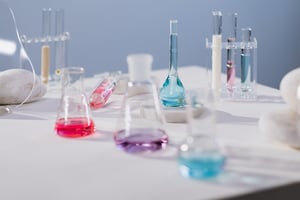More and more consumers are becoming concerned about the health of the planet and environment and...
How Biodegradable Products Can Protect Marine Life From Microplastics in the Ocean
Plastics are used in our lives nearly every day. From water bottles to food packaging to children's toys, plastic has become integral to many industries. While these plastics may be convenient for us, they have an unfortunate impact on the environment, specifically the ocean.
There are an estimated 200 million metric tons of plastic that circulate in marine environments with 11 million metric tons being added into the ocean every year. This has led to nearly 700 species in our oceans being impacted by plastics. One of the most dangerous results is the accumulation of microplastics in the ocean.
Microplastics are constantly being ingested by marine life, and plastics have been found in 60% of all seabirds and 100% of sea turtles. This can lead to life-threatening problems for these creatures, including reduced fitness, limited nutrient uptake, and decreased feeding efficiency.
So, is there anything we can do to help protect marine life from microplastics in the ocean? Luckily, the answer is yes. As sustainability becomes more important to consumers and they learn more about the impacts of microplastics in the ocean, they look to buy more sustainable products. Specifically, there are a few materials that are specifically designed to biodegrade in the ocean.
Preventing the Accumulation of Microplastics in the Ocean with Products that Biodegrade in Seawater
While seawater can present a difficult environment for many products to biodegrade, some materials can biodegrade in salt water. The primary material being cellulose.
Cellulose-Based Materials
Cellulose is a naturally occurring polymer found in plants. This material is used in many applications, from textiles to containers. Commonly, cellulose is used as a bio-based substitute for traditional petrochemical-based plastics, such as polypropylene.
Cellulose-based materials have been found to be biodegradable in marine environments, including the ocean. In fact, some cellulose-based products biodegrade in the ocean in about a month, whereas there has been evidence that petrochemical-based materials can be very persistent in these environments.
Bioplastics
Bioplastics are plastic materials that are made from biological materials rather than petroleum. These biological materials may include vegetable fats or oils, cornstarch, woodchips, or cellulose.
While these bioplastics can use less nonrenewable materials and energy to be created, they may not be fully biodegradable. When creating bioplastic materials, appropriate effort needs to be made to ensure that the bioplastics do not create persistent microplastics in marine environments.
While this may be disheartening to some, others view it as an opportunity. Bioplastics are continually being improved upon and new solutions are being developed. Scientists and researchers alike are looking for ways to improve bioplastic materials to make sure they fully biodegrade in marine environments.
Other Ways You Can Prevent Microplastics in the Ocean
While strides toward better ocean biodegradable products are being made, there are a few things that you can do in the meantime to prevent plastics from ending up in the ocean, including reducing single-use plastics and properly recycling.
Reducing your use of single-use plastics is one of the best ways to limit the amount of plastics you are putting into the environment. Some single-use plastics that are most common in our day-to-day lives include plastic bags, water bottles, cups, straws, take-out containers, and utensils. There are many reusable versions of each of these products, including reusable grocery bags, water bottles, and more.
Recycling appropriate plastic products properly can also keep plastics out of the ocean. When you do use plastics and they can be recycled, it is important to try your best to recycle them. Check with your local recycling center to determine what plastic products they accept and make sure you are recycling accordingly.
Do You Want to Know If Your Products Are Biodegradable? Aropha’s Biodegradation Lab Is For You
At Aropha, we support your biodegradability testing process from start to finish. To start, you will be able to simulate the biodegradability of your product with our machine learning program, ArophaAI. Then, you can send your most promising products to our lab for testing to validate the biodegradability of your products in different environments.
Whether you want to test your packaging, product, or potential bioplastic for biodegradability, our team is here to help. We offer biodegradability testing for numerous environments, including seawater and marine environments.
Contact our team today to learn more.


